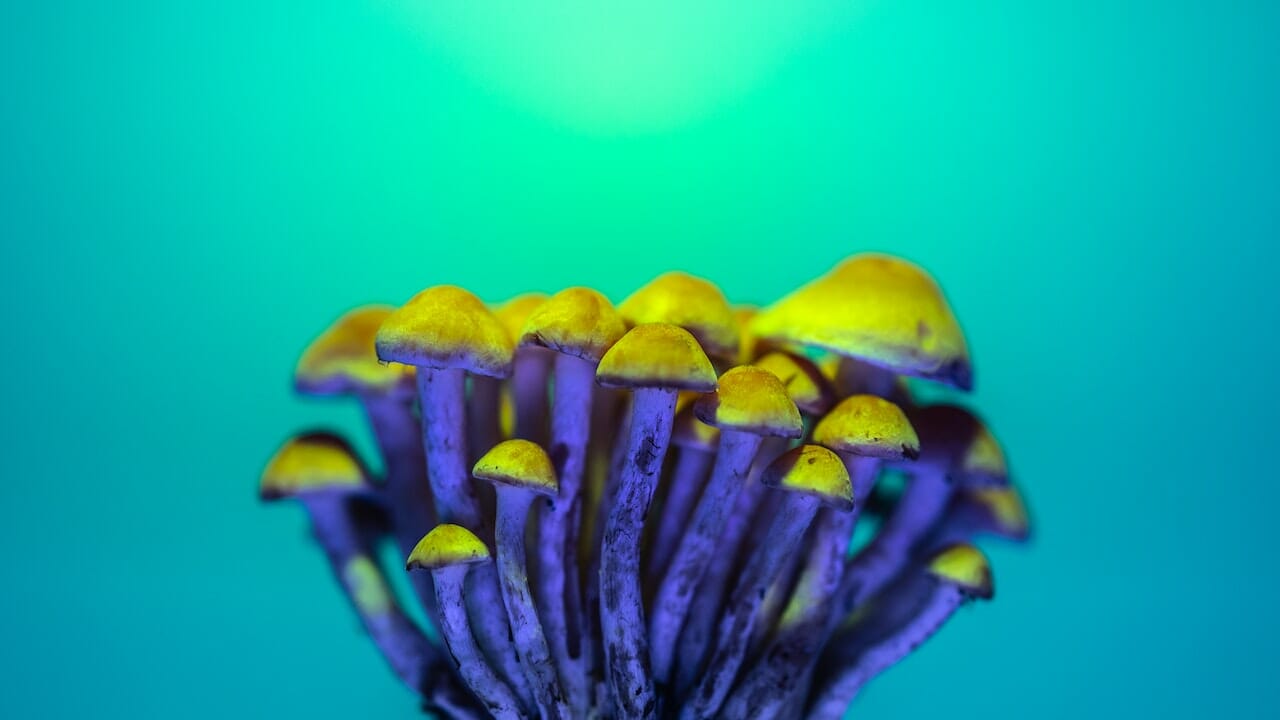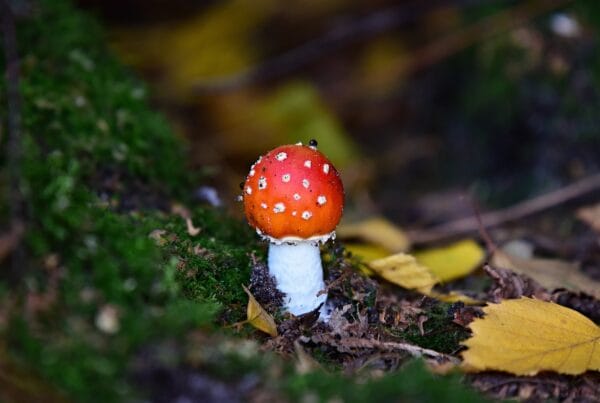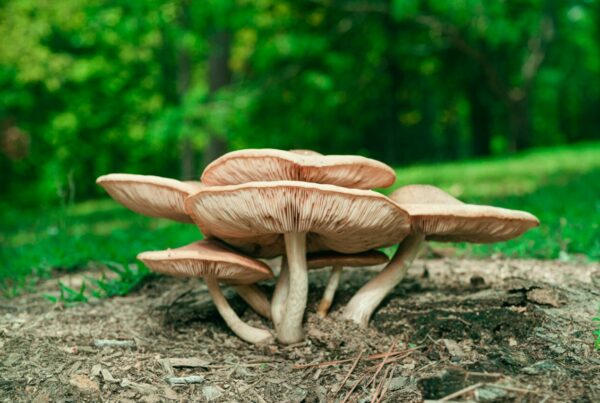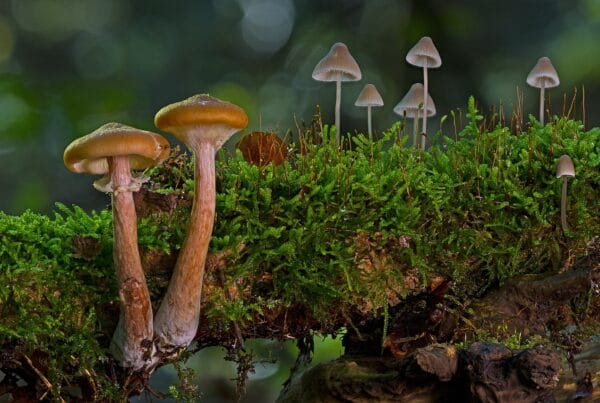Lysergic acid diethylamide (LSD) is a highly potent psychedelic substance, which is extensively studied. Originally known for recreational use, it has evolved into a psychoactive compound with potential benefits for mental health. This new perspective has paved the way for more research on LSD’s effects in more accessible forms, such as LSD edibles.
Key Facts:
- LSD is a powerful hallucinogen, originating from the ergot fungus.
- LSD shares some similarities with psilocybin and interacts with 5-HT2A receptors.
- Effects of LSD include altered visuals, mood changes, dissolution of ego, and pseudo-hallucinations.
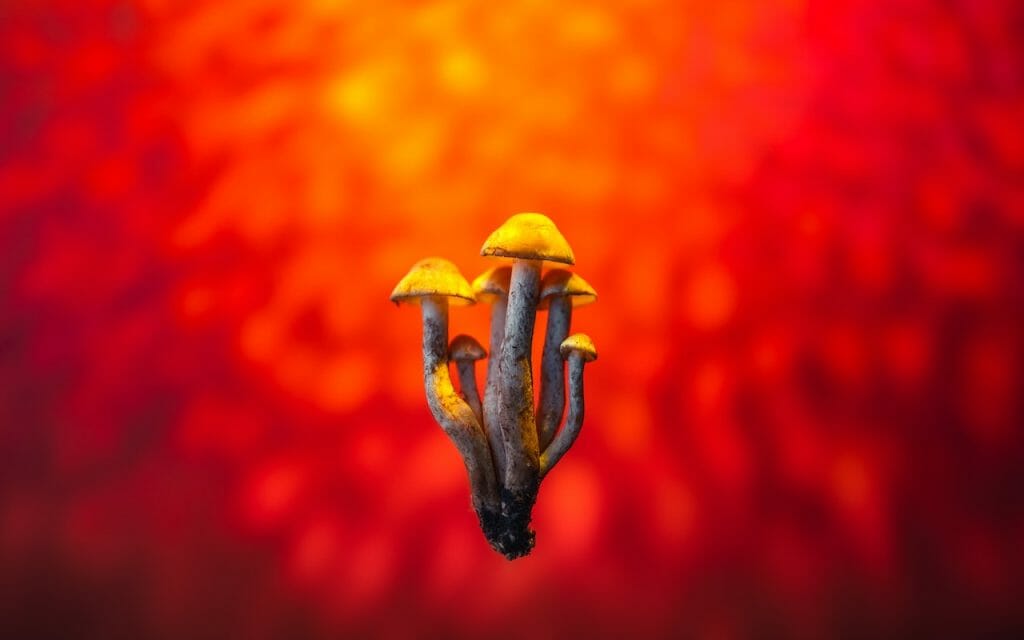
Deciphering LSD
LSD is a remarkably potent hallucinogen, capable of dramatically altering one’s grasp of reality and distorting the senses. It’s derived from “ergot,” a fungus that grows on rye and other grains.
At the molecular level, LSD is a sophisticated chemical belonging to the ergoline family. It comprises a bicyclic hexahydroindole group and a bicyclic quinoline group (lysergic acid). The name ‘Lysergic Acid Diethylamide’ is derived from the functional group attached to its core structure. LSD shares structural similarities with other ergoline alkaloids, such as ergotamine, present in the ergot fungus Claviceps purpurea, and the neurotransmitter serotonin.
The Effects of LSD
Upon consumption, LSD enters the brain and initiates chemical reactions that can persist for multiple hours. LSD can cause the following short-term effects:
- Unforeseeable mood swings
- Distorted perception
- Feeling of dizziness
- Decreased appetite
- Difficulty controlling movement
The Advantages What Are the Benefits of Using LSD?
The potential benefits of LSD are diverse and largely depend on the amount ingested. The majority of research centers on the advantages associated with the intake of small amounts of this psychedelic compound. Here, we explore the potential positive impacts of LSD consumption.
Pain Relief and Neural Development
Researchers at Maastricht University have discovered that a single microdose of LSD can generate pain-alleviating effects that endure for at least five hours, if not more.
In the Cold Pressor Test, where participants immerse their hands in 3°C (37.4°F) water for as long as they can bear, those who had consumed 20 mg of LSD were able to keep their hands submerged 20% longer than the non-users. They also reported fewer sensations of pain and discomfort.
Furthermore, LSD can contribute to the development and growth of the brain’s 86 billion neurons. Moderate doses of LSD, ranging from 5 to 20 ug, increase the levels of BDNF in blood plasma. This is noteworthy because mood disorders like depression, often associated with neuroplasticity problems, might be mitigated due to LSD’s beneficial effects on neuronal health.
Improves Mental Health
Dr. Robin Carhart-Harris from Imperial College London introduced the entropic brain hypothesis. This theory posits that mental health disorders are often a result of rigid thought patterns, perpetuated by an overly active default mode network (DMN). Psychedelic substances like LSD have the potential to disrupt the DMN, increase brain entropy, and promote the dissolution of detrimental neural pathways while fostering the development of beneficial ones.
A study involving over 1,000 individuals who microdosed reported a decrease in depression. Another extensive cross-sectional study indicated a reduction in negative emotions and harmful attitudes, coupled with an increase in open-mindedness and cognitive ability.
Addiction Treatment
A meta-analysis of randomized-controlled clinical trials using LSD in psychiatry concluded that it is most effective in treating alcohol dependence. This conclusion is further reinforced by the positive results experienced by numerous patients treated for alcoholism by Humphrey Osmond and at the Spring Grove Hospital Centre during the 1950s and 1960s.
Reducing Anxiety and Depression in Terminal Patients
According to Dr. Peter Gasser, LSD-assisted psychotherapy can help cancer patients who are terminally ill to reduce their anxiety about dying. It also has the potential to enhance their perceived quality of life. A phase 2 trial is currently under way to explore the potential benefits of LSD therapy for treating depression.
Demystifying LSD Edibles: What They Contain and How They’re Produced
LSD edibles are food and drink items that are infused with the hallucinogenic substance, LSD. This category of edibles can manifest in many forms, from chocolates, candies, and baked goods to more unconventional items like LSD-infused mints.
The Ingredients
- LSD: This is the active ingredient that produces hallucinogenic effects. It’s carefully measured and incorporated into the edible.
- Edible Base: The LSD is usually dissolved or infused into a consumable base such as a gummy, candy, sugar cube, or other ingestible forms. These bases act as the delivery system for the hallucinogenic compound.
- Flavouring and Other Ingredients: The specific edible may contain flavourings, sweeteners, and other ingredients to enhance taste and texture. These could be natural or artificial flavours, colours, and sugars and can vary significantly.
The Manufacturing Process:
- LSD Synthesis: The first step involves chemically producing LSD. This requires in-depth knowledge of organic chemistry, as well as access to necessary chemicals, equipment, and a laboratory environment.
- Liquid Formulation: Once the LSD is synthesized, it is typically transformed into a liquid form by dissolving it in a solvent. This results in a concentrated LSD solution.
- Infusion: The liquid LSD is then integrated into an edible base such as gummy candies, sugar cubes, or blotter paper. The base absorbs the liquid, enabling the oral consumption of LSD.
The Psychedelic Experience of Consuming LSD Edibles
LSD can cause intense visual effects. Colours may seem more vivid, objects might appear to be encircled by halos or rainbows, and shapes can seem to transform. Whether the user’s eyes are open or closed, they may perceive complex, dreamlike images.
LSD, a potent hallucinogenic substance, can significantly alter your perception of yourself and your environment. It can induce a range of mental states, from clear and profound thoughts to disjointed and illogical ones. It can also skew perceptions of time, distance, and body image, and blur the distinction between self and the external world. Some users report synesthesia-like experiences, such as seeing music or hearing colors.
Suggested LSD Products
There is a plethora of LSD edibles available, but it is essential to buy from a trusted dispensary to ensure the edibles contain LSD and not other substances such as PCP, ecstasy, or ketamine.
Deadhead Chemist – LSD Infused Gummies
Deadhead Chemist offers LSD-laced edibles, each containing 100 micrograms of LSD, available in several flavors. Each package contains a single gummy, which has been reported to aid individuals suffering from conditions like obsessive-compulsive disorder (OCD), post-traumatic stress disorder (PTSD), alcoholism, depression, and cluster headaches.
Deadhead Chemist – Mint Tea
Deadhead Chemist’s raspberry mint tea offers an alternative, tastier way to experience the effects of LSD. LSD and similar psychedelics mimic the serotonin neurotransmitter, enhancing the brain’s flow state.
Earthly Delights – Candy Flips
Candy flipping, a practice that originated in the rave culture of the 1980s, continues to thrill modern-day explorers and party enthusiasts. Users often experience profound feelings of love and unity, accompanied by fascinating visual effects like amplified colors, object transformation, and complex geometric patterns.
Concluding Remarks
The historical association of LSD with life-altering experiences continues to intrigue many. As our scientific comprehension of this substance expands, its popularity is consistently rising, with the introduction of LSD edibles creating a unique opportunity for users. These delightful goodies are gaining momentum.
Safely explore the world of LSD with controlled doses for a pleasant experience.
As the leading online provider of premium quality shrooms in Canada, Deadhead Chemist Canada is proud to offer an extensive array of LSD-infused edibles and cannabis products. Take your time to explore our collection, add your chosen products to your cart, and sit back as we handle the delivery aspect. We also offer a variety of psilocybin shrooms, edibles, drinks, and capsules for your convenience. Be sure to check out our LSD delivery page for further details!
Frequently Asked Questions
What separates LSD from psilocybin?
CHARACTERISTICS LSD PSILOCYBIN Source Semi-synthetic chemical compound Naturally occurring in fungi Forms Available Tabs, microdots, liquid, gummies, blotter paper Dried mushrooms, capsules, teas, chocolates Potency Highly potent, dosed in micrograms (ug) Varies with mushroom species and preparation Onset and Duration Quick onset (15-60 minutes), short duration (3-5 hours) Gradual onset (30-60 minutes), moderate duration (4-6 hours)
How can one avoid negative experiences with LSD?
- Choose Your Setting Wisely
- Prepare Your Mindset
- Start with a Small Dose
- Arrange for a Trip Guide
- Create a Serene Environment
- Practice Deep Breathing and Grounding Techniques
- Accept and Let Go
How long do the effects last?
The effects of the acid typically kick in between 30-60 minutes post-consumption. Individuals with a heightened sensitivity to psychedelics may start to feel the effects earlier. In just 15 minutes, you’ll be able to discern if you’ve ingested LSD. The peak of your experience will occur around three hours in, where you might perceive time as slowing down and hallucinations may occur.
Hold on, it’s normal to feel detached from reality at this stage. The peak phase endures between 3 and 5 hours, succeeded by the comedown phase which lasts another 3 to 5 hours.
How does LSD interact with the human body?
LSD mainly interfaces with the brain’s serotonin system by binding to and stimulating the 5-HT2A receptor. This interaction initiates a chain of neurological and physiological responses. Various factors can impact the effects of LSD, which can differ significantly.
Are there different forms of LSD besides edibles?
Yes, LSD comes in multiple forms. The four main types of LSD products are blotter paper, liquid solutions, tablets/microdots, and gelatin sheets.
Further Reading:
| CHARACTERISTICS | LSD | PSILOCYBIN |
| Source | Semi-synthetic chemical compound | Naturally occurring in fungi |
| Forms Available | Tabs, microdots, liquid, gummies, blotter paper | Dried mushrooms, capsules, teas, chocolates |
| Potency | Highly potent, dosed in micrograms (ug) | Varies with mushroom species and preparation |
| Onset and Duration | Quick onset (15-60 minutes), short duration (3-5 hours) | Gradual onset (30-60 minutes), moderate duration (4-6 hours) |

